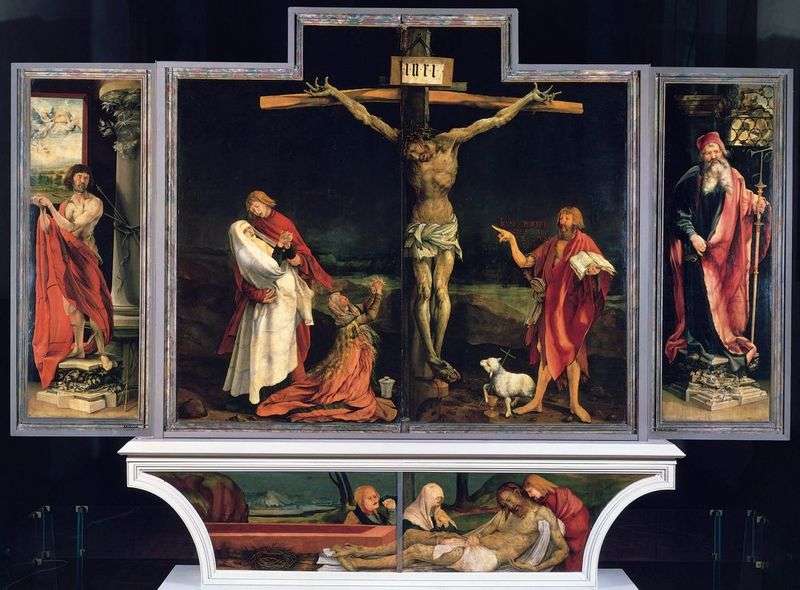
“Isenheim altar” in shape is folded, that is, the altar-folding and was arranged so that during the year different leaflets and Altar paintings opened on certain dates and holidays, corresponding to the religious event.
In Advent and fasting, the altar was closed. This is the first unfoldment of the altar where the “Crucifixion” is depicted. Let’s consider it in detail.
On a bleak dark background, five figures stand out clearly: a deadly gray, mutilated body of crucified Jesus, John the Baptist pointing to him, the Mother of God, supported by the evangelist John, and the kneeling Mary Magdalene. The blood-red cloaks of men, the snow-white handkerchief of the Mother of God, the pearly pink robe of the Magdalene and the gold of her hair are literally pierced by the dazzling bright, literally permeated with suffering, quiet and immensely profound at the Madonna, frenziedly sharp at the Magdalene. Their hands are fine – thin, spiritual, with fingers interwoven in a rush of grief.
The difference between the Isenheim “Crucifixion” and contemporary works on the same subject is immediately evident. Typically, the artists illustrated the scene described in the Gospel of the crucifix on Calvary, with a carefully drawn landscape background, the figures of two crucified Christ with bandits and Roman guards in armor.
This “Crucifixion” is completely cleared of the details. Black lifeless desert in the background does not look like a real landscape. This can only be imagined in a nightmare. It seems that nature has died, and the ray of the sun will never revive the barren plain.
From the composition, the figures of the guards and crucified robbers disappeared, but a completely unusual image appeared-John the Baptist, who, according to the Gospels, had long been put to death by the time of the crucifixion of Jesus. Of course, this character is entered into the picture at the request of the customer. For antonitis it was very important that the image of the healer of epilepsy be present in the “healing” altar.
But this addition was necessary to the artist very opportunely: the appearance of John the Baptist finally translates the entire scene from the illustrative plan into a symbolic one. John the Baptist points to the Crucified with an eloquent gesture, at his feet – a symbolic lamb with a cross, the blood flowing from his throat, fills the cup of the Sacrament. The words of his prediction are inscribed on John’s face: “He must grow, but I must decrease.”
The crucifixion of Christ is perceived as a catastrophe on a universal scale, His death as a tragedy of human history. And in the lower part of the altar, “Lamentation of Christ” is the dead body of the Savior taken from the cross before His position in the grave. The apostle John bent over the body of Christ. Behind him, breaking the hand in flour and hidden by a handkerchief, stands the Mother of God, behind her the figure of Mary Magdalene.
The artist is very close to the late Gothic with its unrestrained, bordering with ecstasy expressiveness. In the Isenheim “Crucifixion” the figure of Jesus is huge, it almost twice exceeds the others. This is the principle of medieval painting, which does not yet know the laws of perspective: the size of the figures determines not the remoteness of objects, but the spiritual significance of images. Such a violation of scale looked natural in the flat compositions of medieval masters. But in the picture, where the background has real depth, and the figures – the real volume, it acquires a completely different sound, majestic and frighteningly irrational.
On the fixed leaves to the left and right of the Crucifixion are depicted the balanced, proportionally flawless figures of St. Anthony and St. Sebastian, they are not as expressive as the central composition.
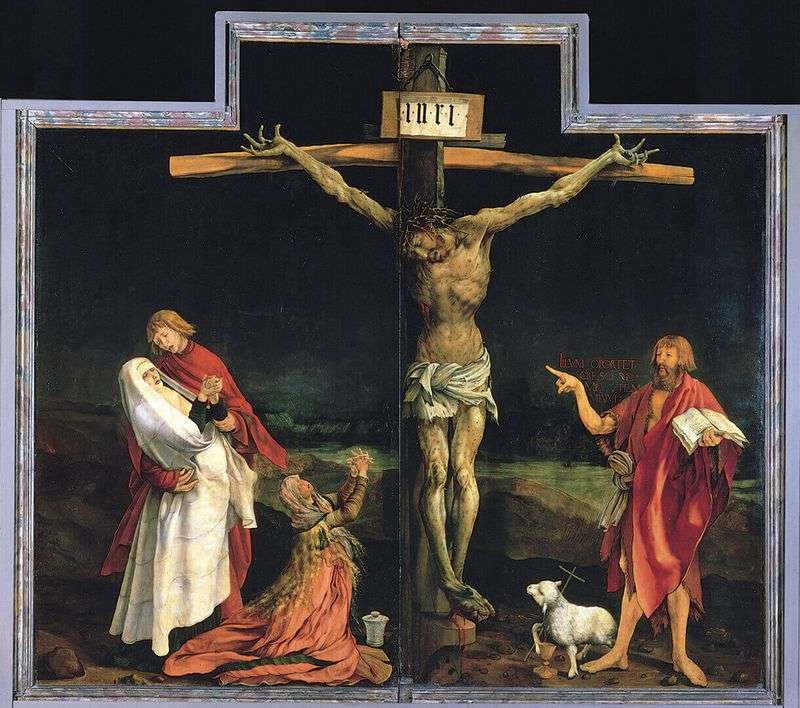 The Crucifixion by Matthias Grunewald
The Crucifixion by Matthias Grunewald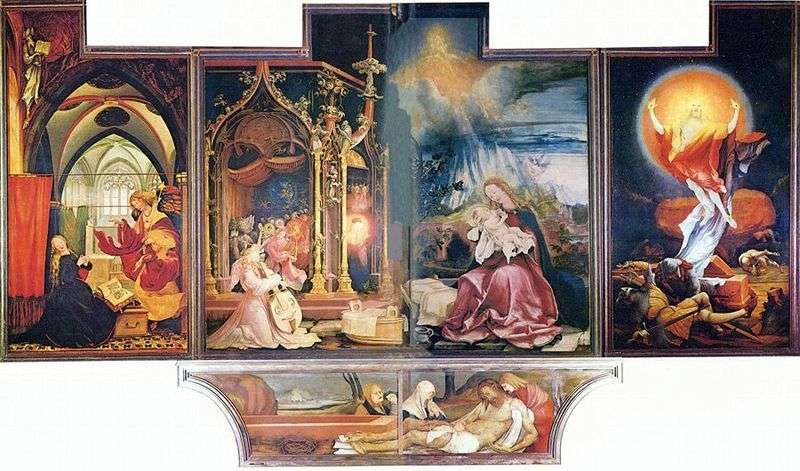 Isenheim altar, second sweep by Matthias Grunewald
Isenheim altar, second sweep by Matthias Grunewald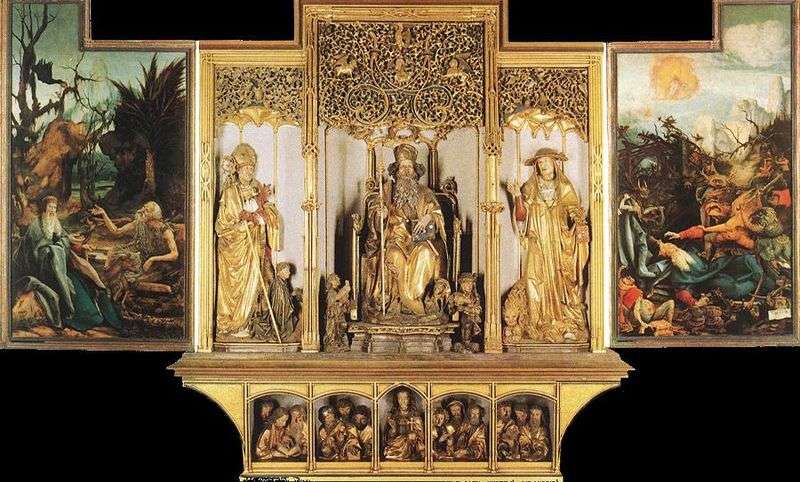 The Isenheim altar sculptural composition by Matthias Grunewald
The Isenheim altar sculptural composition by Matthias Grunewald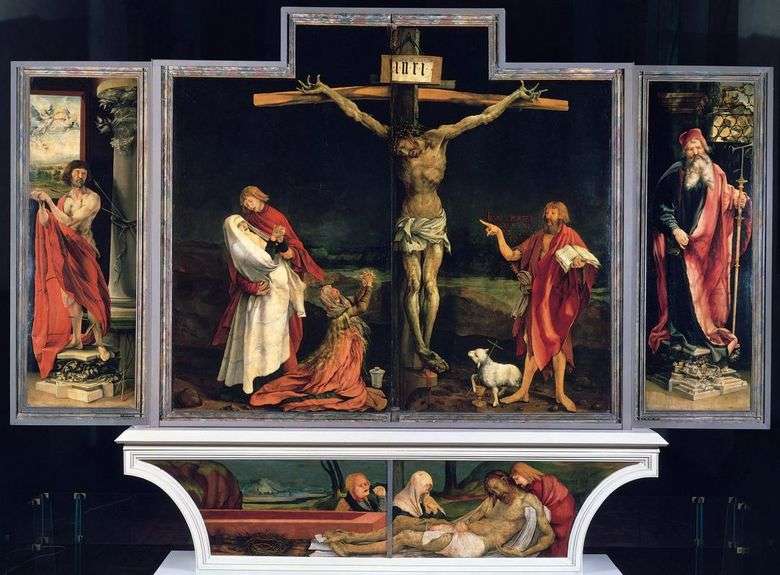 Isenheim Altar, el primer barrido – Matthias Grunewald
Isenheim Altar, el primer barrido – Matthias Grunewald Isenheim Altarpiece by Matthias Grunewald
Isenheim Altarpiece by Matthias Grunewald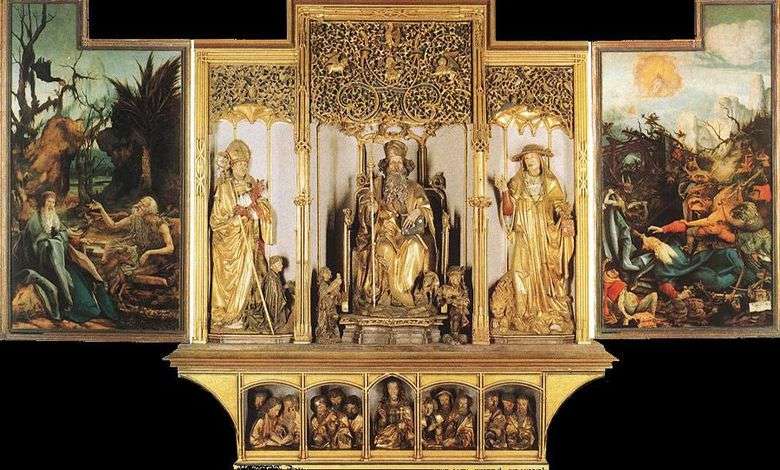 Composición de la escultura del altar Isenheim – Matthias Grunewald
Composición de la escultura del altar Isenheim – Matthias Grunewald Altar de Isenheim, el segundo barrido – Matthias Grunewald
Altar de Isenheim, el segundo barrido – Matthias Grunewald Madonna and Child by Andrea Mantegna
Madonna and Child by Andrea Mantegna